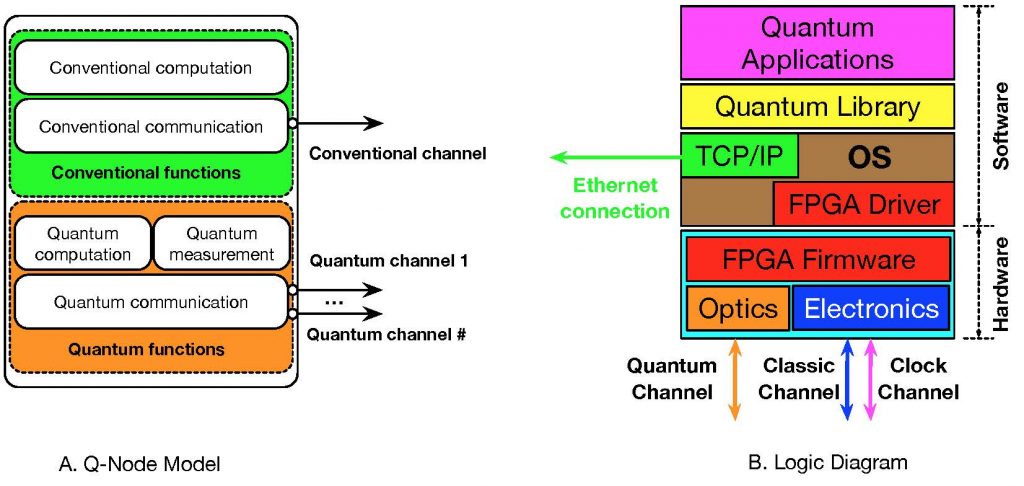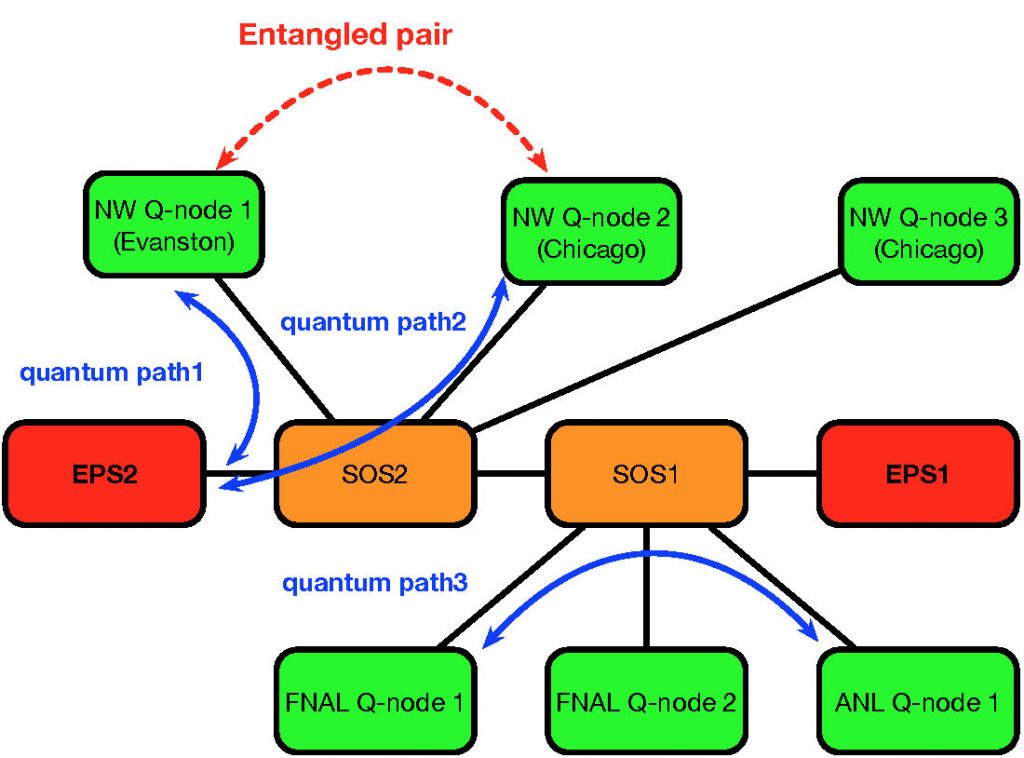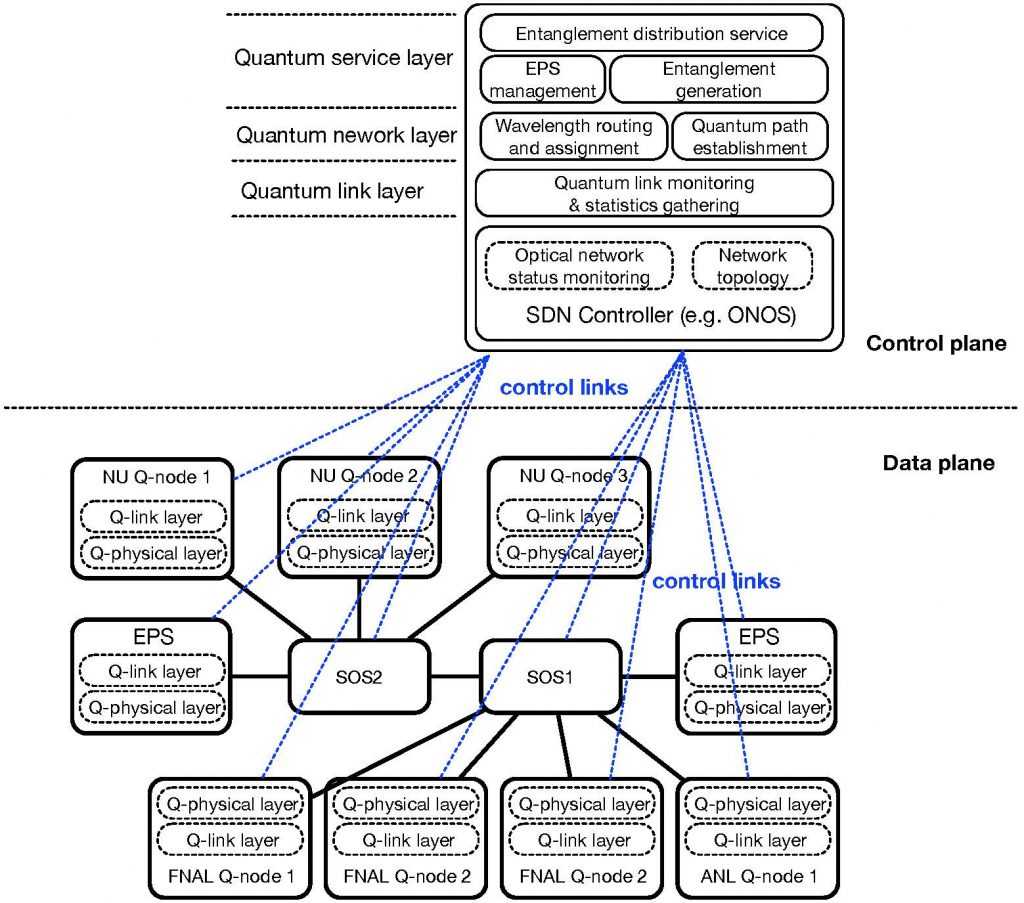Coexist with tradition network
IEQNET coexists with traditional network in the same optical fiber transmission system and shares the same DWDM network components. In IEQNET, quantum channels operate at 1310 nm (O-band) while conventional traffic channels runs at other wavelengths, such as 1550 nm (C-band). Quantum signals and messages are transmitted across quantum channels. Conventional traffic channels serve two purposes in IEQNET:
- as communication channels between Qnodes to exchange data and timing messages to make quantum correlation measurements,
- as test channels to stress the quantum channels thereby to determine the limits of classical/quantum channel coexistence.
Q-node, identifier, and addressing
Q-nodes in IEQNET are much like their classical counterparts (i.e., nodes), representing the communication parties in quantum networks. A Q-node performs both conventional and quantum functions. The major functions include:
- to execute quantum communication,
- to execute conventional computation and communication. For example, a Q-node will exchange messages with other Q-nodes via conventional traffic channels to make quantum correlation measurements.
As illustrated below, a Q-node has two types of communication channels, (a) quantum channel(s) to send/receive quantum signals and messages, and (b) conventional channel(s) to transmit conventional traffic.
In conventional networks, a channel endpoint is uniquely identified by a layer-2 physical address, which is typically vendor-assigned; and a node is uniquely identified by a layer-3 logical address (e.g., IP address). In operation, a layer-3 logical address is mapped and translated into a layer-2 physical address.
In IEQNET, a Q-node is assigned an IP address to uniquely identify the node. Each of its conventional channel endpoints is identified and addressed by the corresponding physical address. In addition, a Q-node enumerates and numbers its quantum channels. The <Q-node ip, quantum channel #> pair is used to identify and address a particular quantum channel endpoint.
Q-node design
Proceedings Volume 11726, Quantum Information Science, Sensing, and Computation XIII; 1172602 (2021) https://doi.org/10.1117/12.2588007
Quantum paths and routing
Routing is a fundamental network function. Multihop networks requires a means of selecting paths through the network. Due to technology immaturity in quantum memory and quantum computation, IEQNET does not perform routing in the quantum domain. Instead, IEQNET will use SDN technology to perform traditional wavelength routing and assignment in optical networks to establish quantum paths between Q-nodes, or between Q-nodes and EPS(es).
As illustrated below, optical switches – SOS1 and SOS2 are dynamically programmed to establish multiple quantum paths:
- Quantum path1 between EPS2 and NU Q-node1
- Quantum path2 between EPS2 and NU Q-node 2
- Quantum path3 between FNAL Q-node1 and ANL Q-node1
Quantum path and routing
OSTI.GOV Technical Report: Illinois-Express Quantum Networks (IEQNET) https://doi.org/10.2172/1616300
Support multi-users, flexible, and resilient network configurations
To aid in supporting multiple users on a scalable network, IEQNET will experiment with multi-wavelength entangled photon sources combined with software-controlled all-optical switches. For instance, EPS2 will be capable of generating at least 4 separate wavelengths of light or equivalently two different photon pair wavelengths. If SOS2 has 8 output ports, then up to 4 of 8 potential users can simultaneously be receiving a photon stream that is entangled with one other user. That is, 4 users can simultaneously use the quantum network. The below figure shows the concept for a simple 4 user system. The number of possible inter-connections grows quickly with the number of users, but the NxN switch is fully reconfigurable allowing any desired configuration.

Depiction of entanglement distribution using a 4-wavelength EPS connected to a 4×4 spatial switch. Three configurations (Left, Right, Center) allow any two users and the remaining two users to share entanglement (shared entanglement indicated by dotted oval).
OSTI.GOV Technical Report: Illinois-Express Quantum Networks (IEQNET) https://doi.org/10.2172/1616300
This design is scalable, since low-loss technology is readily available for SOS2 to have 32 (or more) output ports. Additionally, the EPS pair-generation bandwidth can be quite broad, e.g. about 1 THz for fiber-based systems and > 6 THz for systems based on c(2) nonlinear waveguides. The number of available channels from the EPS is thus largely limited by filtering technology, and if 100 GHz-like grids are implemented (as commonly used at 1550 nm) then 8 – 64 routable quantum channels would be achievable.
This design allows for a central multi-wavelength EPS to service many users, and also allows for the possibility of quantum-channel redundancy for added resiliency. For instance, if EPS1 for some reason becomes inoperable then the system could potentially be configured so that EPS2 sends a signal and idler photon pair (at two different wavelengths) to the ANL node. ANL would then configure a local all-optical tunable add-drop multiplexer to drop the signal wavelength and allow the idler wavelength to pass to FNAL. In this way ANL and FNAL could share entanglement even if the FNAL switch is not directly connected to the multi-wavelength quantum switch at Starlight.
A layered architecture and a centralized control
Inspired by the Internet architecture, the proposed IEQNET implements a similar layered quantum networking architecture, which describes how quantum network functions are vertically composed to provide increasingly complex capabilities. IEQNET layered quantum networking architecture relies on five key vertical layers:
- Quantum physical layer deals with the physical connectivity of two communicating quantum nodes. It defines quantum channel frequencies, signal rates, photon pulses used to represent quantum signals etc.
- Quantum link layer is the protocol layer in Q-nodes that handles the transmitting of quantum signals and messages across quantum channels. It is also be responsible for monitoring quantum link status.
- Quantum networking layer refers to use SDN to perform traditional wavelength routing and assignment in optical networks to establish quantum paths between Q-nodes, or between Q-nodes and any EPS’s.
- Quantum service layer refers to provide quantum entanglement distribution service to users and applications. Quantum service layer functions include EPS management, entanglement generation, and entanglement distribution.
IEQNET uses a centralized control style. As illustrated below, SDN decouples the control and data plane. In the control plane, the SDN controller monitors the status of IEQNET. IEQNET control and management software runs on top of the controller to perform various functions, such as wavelength routing and assignment for quantum channels, dynamical quantum path establishment, and quantum entanglement distribution. In data plane, quantum signals and messages are transmitted across quantum channels between Q-nodes, or between Q-nodes and EPS’s.
A layered architecture and a centralized control
Proceedings Volume 11726, Quantum Information Science, Sensing, and Computation XIII; 1172602 (2021) https://doi.org/10.1117/12.2588007



